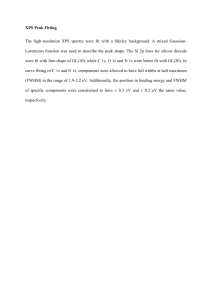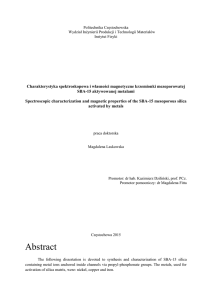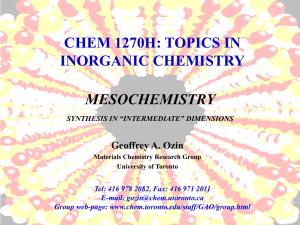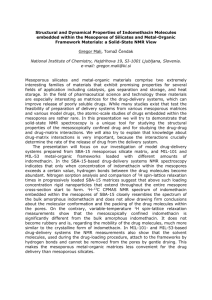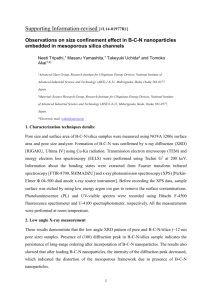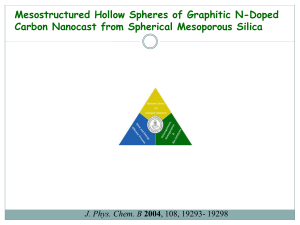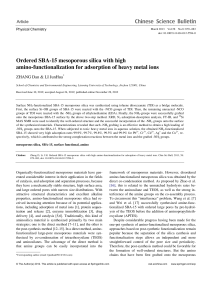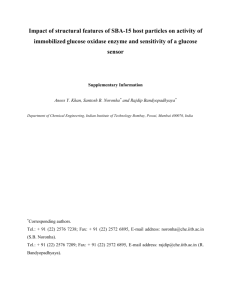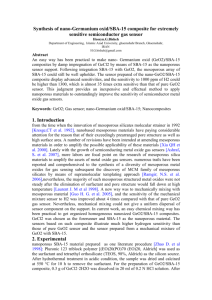synthesis of ordered mesoporous silica sba-15 for
advertisement
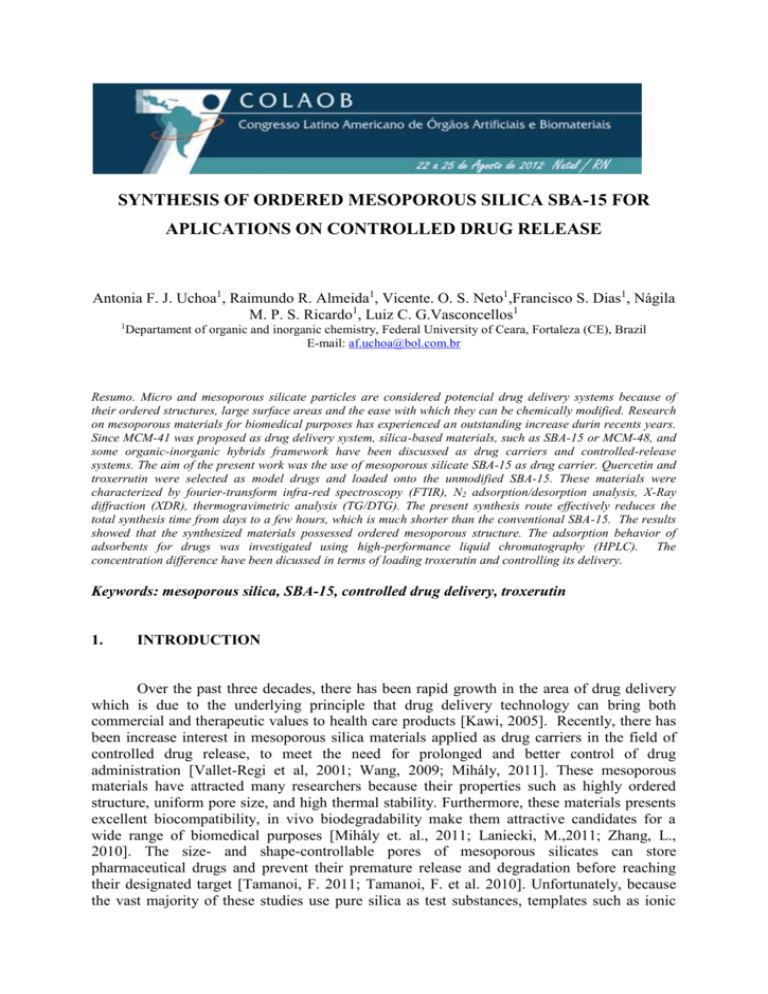
SYNTHESIS OF ORDERED MESOPOROUS SILICA SBA-15 FOR APLICATIONS ON CONTROLLED DRUG RELEASE Antonia F. J. Uchoa1, Raimundo R. Almeida1, Vicente. O. S. Neto1,Francisco S. Dias1, Nágila M. P. S. Ricardo1, Luiz C. G.Vasconcellos1 1 Departament of organic and inorganic chemistry, Federal University of Ceara, Fortaleza (CE), Brazil E-mail: af.uchoa@bol.com.br Resumo. Micro and mesoporous silicate particles are considered potencial drug delivery systems because of their ordered structures, large surface areas and the ease with which they can be chemically modified. Research on mesoporous materials for biomedical purposes has experienced an outstanding increase durin recents years. Since MCM-41 was proposed as drug delivery system, sílica-based materials, such as SBA-15 or MCM-48, and some organic-inorganic hybrids framework have been discussed as drug carriers and controlled-release systems. The aim of the present work was the use of mesoporous silicate SBA-15 as drug carrier. Quercetin and troxerrutin were selected as model drugs and loaded onto the unmodified SBA-15. These materials were characterized by fourier-transform infra-red spectroscopy (FTIR), N2 adsorption/desorption analysis, X-Ray diffraction (XDR), thermogravimetric analysis (TG/DTG). The present synthesis route effectively reduces the total synthesis time from days to a few hours, which is much shorter than the conventional SBA-15. The results showed that the synthesized materials possessed ordered mesoporous structure. The adsorption behavior of adsorbents for drugs was investigated using high-performance liquid chromatography (HPLC). The concentration difference have been dicussed in terms of loading troxerutin and controlling its delivery. Keywords: mesoporous silica, SBA-15, controlled drug delivery, troxerutin 1. INTRODUCTION Over the past three decades, there has been rapid growth in the area of drug delivery which is due to the underlying principle that drug delivery technology can bring both commercial and therapeutic values to health care products [Kawi, 2005]. Recently, there has been increase interest in mesoporous silica materials applied as drug carriers in the field of controlled drug release, to meet the need for prolonged and better control of drug administration [Vallet-Regi et al, 2001; Wang, 2009; Mihály, 2011]. These mesoporous materials have attracted many researchers because their properties such as highly ordered structure, uniform pore size, and high thermal stability. Furthermore, these materials presents excellent biocompatibility, in vivo biodegradability make them attractive candidates for a wide range of biomedical purposes [Mihály et. al., 2011; Laniecki, M.,2011; Zhang, L., 2010]. The size- and shape-controllable pores of mesoporous silicates can store pharmaceutical drugs and prevent their premature release and degradation before reaching their designated target [Tamanoi, F. 2011; Tamanoi, F. et al. 2010]. Unfortunately, because the vast majority of these studies use pure silica as test substances, templates such as ionic and nonionic surfactants or amphiphilic block copolymers need to be removed from the as prepared products by calcination [Zhao, D. et al, 2000] or extraction [Grieken, R., 2003] after defining the wall structure of mesoporous materials, the template removing process takes a lot of time and energy [Jin, L., 2010]. In general, a typical synthesis of mesoporous silica ordered involves a two-step process in which the first step involves the self-assembly of silica and template species at a given reaction temperature under acidic or basic conditions, and the second one involves the mesostructure expansion and consolidation of siliceous pore walls usually performed under static conditions at a higher temperature (e.g., at 100 °C) normally take from several hours to days [Kao, H-M, 2010; Landskron, K.,2009]. Afterward, the extraction of the templates is carried out by stirring the materials with appropriate solvents which further takes several hours. Numerous methods have been developed for the synthesis of mesoporous materials in order to reduce reaction time and temperature to save energy and cost without affecting the quality of the materials. In this regard, alternatives synthesis methods of these materials, such as solvent-free synthesis, microwave heating, and electrochemical methods deserve particular attention [ Ahn, W-S, 2008]. Sonochemical methods are more and more often used for the synthesis of novel nanomaterials because can lead a substantial reduction in crystallization time compared with conventional oven heating when nanomaterials are prepared. The main event in sonochemical synthesis or sonochemistry is the creation, growth, and collapse of a bubble that is formed in liquid, known as an acoustic cavitation which creates the high transient temperature and high pressure of several thousand bars in the solution [Kao, H-M, 2010; Ahn, W-S, 2008]. This study shows that the sonochemical mediated synthesis of SBA-15 has several advantages: an easy way to control the temperature and time of the synthesis and significant reduction in the total synthesis time. By varying the time of the synthesis, the structural properties of the SBA15 materials can be finely tuned. The surface physical and chemical properties of materials were investigated by FTIR, XRD, N2 adsorption/desorption analysis, and TG/DTG. This work describes the adsorption of quercetin (β-glicosidase, antioxidant) and troxerrutin (cicatrização de defeitos endoteliais capilares e proteção do fígado), on the non-modified SBA-15. 2. MATERIALS AND METHODS MATERIALS Chemicals used in this study included pluronics P123 (MW: 5800, Aldrich), (PEO20PPO70PEO20), as structure directing agent. Tetraethyl orthosilicate [TEOS, (CH3CH2O)4Si, 98%, Aldrich], was employed as silica precursor. Ethanol (95%), hydrochloric acid (HCl, 37%), sodium chloride (NaCl). The troxerrutina was kindly supplied by company Flora Brasil (Fortaleza-Ceará). All the reactants were used as received. SYNTHESIS OF MESOPOROUS SILICA The SBA-15 samples were synthesized under acidic conditions using triblock copolymer Pluronic P123 (EO20PO70EO20, Aldrich) as the template and tetraethylorthosilicate (TEOS, Aldrich) as a silica source, with addition of KCl, for enhanced stability and ordering. The synthesis composition was analogous to that reported elsewhere [2]. In a typical synthesis, 3.2 g of Pluronic P123 and 8,8 g of NaCl was dispersed in 100 mL of 2 mol. L-1 HCl solution at 40°C. This mixture was then subjected to sonication using an ultrasonic digital, type 450 Digital Sonifier (Branson, Germany), with an adjustable power output (maximum 200 W at 20 kHz) to obtain a homogeneous solution. Afterwards, 6.82 g of TEOS was added into the solution. The samples were sonicated immediately at different time (5, 10, 20 30,and 40 min), at 40°C. The while solid product was collected by centifugation, dried at 100 °C for overnight. The extraction of template was carried from the as-synthesized material by using microwave in a mixture 1:1 acetona/ethanol for few minutes, and this was repeated tree times. Finally, the material was filtered, and dried at 110 °C. We denoted this material as SBA-15-UW. CHARACTERIZATION X-ray diffractograms were obtained on a PANalytical X’Pert PRO MPD diffactometer using Co Kradiation (λ = 1,7889 Å) at 45 kV and 40 mA. The data were collected from 0.5 to 5 of 2θ values with a step size of 0,02°. The unit cell parameter (𝑎ℎ𝑒𝑥 = 2𝑑100 /√3 ) was determined from the d100 reflections for SBA-15 type materials. Nitrogen physisorption measurements were carried out a 77 K using Micromeritics ASAP 2020. The pore size distributions were calculated from the desorption branch of the isotherms with the BJH method. Samples were treated at 250 °C for 3h before measurements. The thermogravimetric measurements were performed with a TA-60WS thermogravimetric analyzer (TA Instruments) with a heating speed of 10°C/min in nitrogen flow. FTIR spectrum was recorded in KBr pellets on a FTLA 1200 (Bomem) spectrophotometer. TROXERRUTIN LOADING Powdered mesoporous samples were loaded with troxerrutin by soaking them, under continous magnetic stirring for 96 h at room temperature, into a aqueous solution (40 mg/mL) of troxerrutin. A 1:1 (by weight) ratio of troxerrutin to solid sample was used. Then the Trox loaded SBA-15 was separated by filtration and dried under atmosphere. The loading capacity was calculated by measuring the difference in weight to totally dried solid before and after the loading. 3. RESULTS AND DISCUSSION The X-ray diffraction patterns measured for the starting materials are show in Fig. 1. The SBA-15 material exhibited a good 2D hexagonal as evidenced by the narrow (100) reflection and the clearly resolved higher order reflections. All materials exhibited only one broad low-angle reflection, indicative of a lower degree of long-range order. There is no significant difference in the XRD patterns for the SBA samples synthesized under sonication with a long period. The cell parameters (table 1) are basically unaltered for different reaction times. The results show that a short sonication treatment of 10 min is sufficient to obtain ordered SBA-15 silicas. The unit cell parameter a, which was calculated from the (100) diffraction peak was 179,63Å and 182, 27Å. (100) Intensity [A. U.] SBA-15-UC-5 SBA-15-UW-10 SBA-15-UC-20 SBA-15-UC-30 SBA-15-UC-40 1 2 3 4 5 2 Fig. 1. XRD patterns of extracted SBA-15 materials with different times of the synthesis (5 min, 10 min, 20 min, 30 min, 40 min). [note: C – calcinated; U – ultrasound; W – microwave) The nitrogen sorption isotherms of all materials are shown in Fig. 2. All the isotherms are of Type IV according to the IUPAC classification, with H1 hysteresis loops, characteristic of mesoporous materials with a cylindrical pore arrangement. The pronounced uptake at relative pressures around 0,4 P/P0 correspond to capillary condensation in the pores. The sharp capillary condensation step indicated a relatively narrow pore size distribution 4.9 nm, which is considerably larger than the 3.5 nm pore size obtained from the conventional synthesized SBA-15 sample. The surface areas and pore diameters were increased initially with increasing the reaction time at 40°C. All SBA-15 materials show same type of isotherms. Table 1. Textural characteristic of the studied mesoporous silica materials Samples SBET (m2/g) Vp(cm3/g) Dp (nm) a0 (nm) Wall thickness (nm) SBA-15-UW-10 415,16 0,568 3,75 17,96 14,21 SBA-15-UC-20 512,18 0,600 4,65 18,27 13.62 SBA-15-UC-30 524,75 0,599 4,21 18,27 14,06 400 300 dV/dD Volume adsorbed (cm /g STP) 250 300 3 3 Volume adsorbed (cm /g STP) dV/dD 350 10 20 30 40 50 60 70 80 90 Pore width (nm) 200 150 20 40 250 60 80 100 120 140 Pore width (nm) 200 150 100 0,0 0,2 0,4 0,6 0,8 1,0 100 0,0 0,2 Rel. Pressure (P/P0) 0,4 0,6 0,8 1,0 Rel. Pressure (P/P0) a b 400 dV/dD 300 3 Volume adsorbed (cm /g STP) 350 0 20 40 60 250 80 100 120 140 160 Pore Width (nm) 200 150 100 0,0 0,2 0,4 0,6 0,8 1,0 Rel. Pressure (P/P0) c Fig. 2. N2 adsorption-desorption isotherms of (a) SBA-15-UW-10, (b) SBA-15-UC-20 and (c) SBA-15-UC-30. The pore distribution curve for each isotherm is show as inset. The framework vibrations of calcined and extracted siliceous SBA-15 materials were analyzed by FT-IR spectroscopy and are presented in Fig. 3. FTIR spectrum of SBA-15 is characteristic of a pure-silica material, in which the stretching vibration modes of surface silanol groups at ca. 3700–3200 cm-1 are clearly observed. The width of this band together with the presence of another broad vibration in the 1650–1600 cm-1 range, ascribed to the δHOH (H2O) points to the existence of adsorbed water on the material surface. Moreover, in the 1250–1000 cm-1 range, high-intensity bands attributed to νSiO of siloxane groups (Si–O–Si) are observed. Asymmetric stretching vibrations of Si–O–Si (νSiO) at ca. 1080 cm-1, symmetric stretching vibrations from Si–O bonds (νSiO) at ca. 800 cm-1 and bending vibrations from Si–O–Si (δSiOSi) a 460 cm-1 are clearly observed. The presence of free silanol groups (Si–OH) is evidenced by the presence of a acute signal at 3745 cm-1 (νO–H) together with a weak band at ca. 980 cm-1 (νSiO). 800 954 SBA-15-UC-20 1635 SBA-15-UW-10 2980 970 806 Transmitance % 800 950 1645 1460 1375 2975 Transmitance % 2879 1730 1641 1463 SBA-15-U-20 SBA-15-U-10 1080 4000 3500 3000 2500 2000 1500 1000 500 4000 3500 3000 2500 2000 1500 1000 500 -1 Wavenumber (cm ) -1 Wavenumber (cm ) a b Transmitance % 800 954 2975 1724 1637 SBA-15-UC-30 SBA-15-U-30 4000 3500 3000 2500 2000 1500 1000 500 -1 Wavenumber (cm ) c Fig. 3. FT-IR spectra of (a) SBA-15-UW-10, (b) SBA-15-UC-20 and (c) SBA-15-UC-30. All spectra shown before and after extraction of surfactant. TROXERUTIN RELEASE The results of the troxerutin release from the SBA-15-UW-10 mesoporous silica are plotted in Fig.4. The concentration of troxerutin release in SBF at pH 7,4 as a function of time was determined by HPLC. Evaluated was monitored at 260 nm. 100 % Trox 80 60 40 20 0 0 5 10 15 20 25 30 35 Tempo (h) 100 % Trox 80 60 40 20 0 0,0 0,2 0,4 0,6 0,8 1,0 Tempo (h) Fig. 4. In vitro release of troxerutin from SBA-15-UW-10 Since in vitro dissolution testing is important for drug development and quality control, it has been used in this study to investigate the difference in the release rate of model drugs from SBA-15 samples into SBF medium to evaluated the best formulation. As show in Fig. 4 the initial release is assigned to the immediate release and dissolution of the drug moiety located on the surface of disc. These systems exhibit different release rate refers to the amount of drug incorporated, followed by a rate constant for the subsequent hours. Different types of release may be related to the interaction between the drug and the mesoporous silica via hydrogen bonds due to the affinity of the functional groups of molecules Trox and silanol groups on the sides of the silica. 4. CONCLUSIONS In summary, was demonstrated that the sonochemical mediate synthesis of mesoporous silica can reduce the synthesis time from days to few hours. It is an easy way to control the synthesis conditions, and most importantly the structural properties of the SBA-15 materials can be finely tuned by varying the synthesis temperature and duration. The kinetics of drug release troxerutin through the silica matrix used has shown to have a release kinetics efficient and adequate to its purpose. The adsorption capacity and release behavior of Trox model drug are found to be highly dependent on the different properties of these drug molecules and surface properties of SBA-15. 5. ACKNOWLEDGMENT Financial support by Fundação Cearense de Apoio ao Desenvolvimento Científico de Tecnológico (FUNCAP). 6. REFERENCES 1. A. Szegedi, M. Popova, I. Goshev, J. Mihály. Journal of Solid State Chemistry 184 (2011) 1201–1207 2. Arudra Palani a, Hao-Yiang Wub, Chun-Chiang Ting a, Shanmugam Vetrivel a, Kandaiyan 3. D.Y. Zhao, J.L. Feng, Q.S. Huo, N. Melosh, G.H. Fredrickson, B.F. Chmelka, G.D. Stucky. Science 279 (1998) 548–552. 4. Fu Tingming, Guo Liwei, Le Kang, Wang Tianyao, Lu Jin. Applied Surface Science 256 (2010) 6963–6968 5. Jie Lu, Zongxi Li, Jeffrey I. Zink, Fuyuhiko Tamanoi. Nanomedicine: Nanotechnology, Biology and Medicine,8(2010)212-220. 6. M. Vallet-Regi, Ramila, R. P. del Real, J. Perez-Parient. Chem.Mater. 13(2001)308-311 7. Paritosh Mohanty, Nyi Myat Khine Linn, and Kai Landskron. Langmuir 2010, 26(2), 1147–1151 8 Qianjun He, Jianlin Shi, Feng Chen, Min Zhu, Lingxia Zhang. Biomaterials 31 (2010) 3335–3346 9. R. van Grieken, G. Calleja, G.D. Stucky, J.A. Melero, R.A. Garcia, J. Iglesias. Langmuir 19 (2003) 3966– 3973. 10. Shanmugapriya, Anthony S.T. Chiang c, Hsien-Ming Kao. Microporous and Mesoporous Materials 131 (2010) 385–392 11. Sh. Wang, Micropor. Mesopor. Mater. 117 (2009) 1–9 12. S.-W. Song, K. Hidajat, and S. K. Langmuir 2005, 21, 9568-9575
